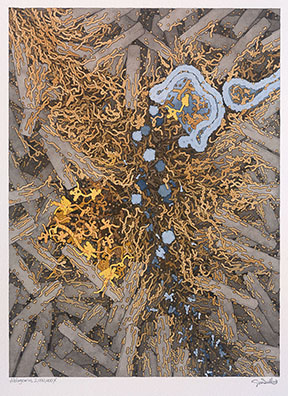Abiogenesis

Amidst a flurry of creative activity at the Djerassi residency, I hid away in my studio for most of the week and finished my second watercolor painting. “Abiogenesis” depicts the dawn of life, when molecules gained the ability to replicate. The painting brings together many speculations about how this occurred, based on many exciting avenues of current research. The picture shows a cavity in a mineral deposit at an alkaline hydrothermal vent. Nucleotide and lipid building blocks are flowing in from lower right, presumably formed from simple chemical materials. The nucleotides interact with the mineral crystals, catalyzing the formation of RNA strands. The molecules in brightest yellow are the key development: one RNA molecule fortuitously had the ability to replicate other RNA strands, and has made many copies of itself. I have shown them sequestered in a small pocket, where they are not distracted by other RNA strands. The molecules in blue are simple lipids that have a useful property: they assemble into membranes that allow the nucleotides, but not RNA, to cross. So, if a closed vesicle is formed with a replicator inside (like the autophagy-type vesicle forming at top right), nucleotides can enter and the RNA products will be retained inside, forming the first protocell.
